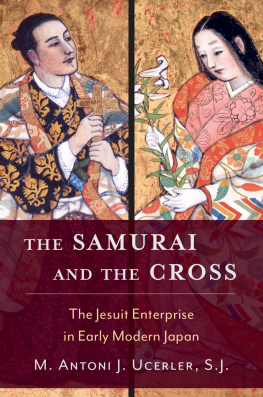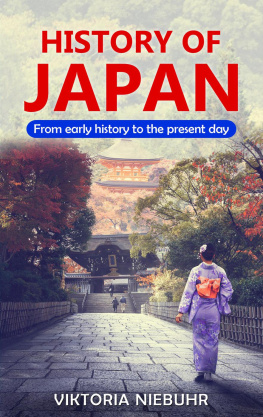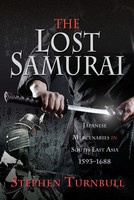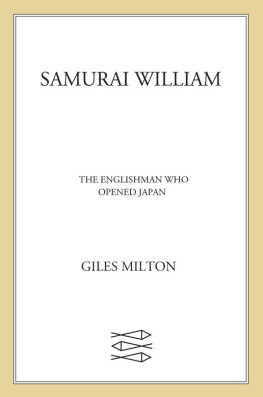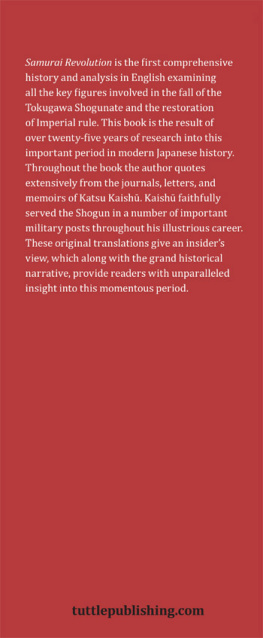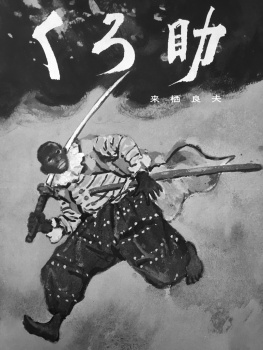The Samurai and the Cross

Oxford University Press is a department of the University of Oxford. It furthers the Universitys objective of excellence in research, scholarship, and education by publishing worldwide. Oxford is a registered trade mark of Oxford University Press in the UK and certain other countries.
Published in the United States of America by Oxford University Press
198 Madison Avenue, New York, NY 10016, United States of America.
Oxford University Press 2022
All rights reserved. No part of this publication may be reproduced, stored in a retrieval system, or transmitted, in any form or by any means, without the prior permission in writing of Oxford University Press, or as expressly permitted by law, by license, or under terms agreed with the appropriate reproduction rights organization. Inquiries concerning reproduction outside the scope of the above should be sent to the Rights Department, Oxford University Press, at the address above.
You must not circulate this work in any other form and you must impose this same condition on any acquirer.
Library of Congress Control Number: 2022936372
ISBN 9780195335439
eISBN 9780197640357
DOI: 10.1093/oso/9780195335439.001.0001
Dedicated to the memory of
Pedro Arrupe, S.J. & Adolfo Nicols, S.J.
Two Wise Men from the West who promoted a genuine encounter with the East
Contents
Courtesy of the Geography and Map Division, Library of Congress, Washington, D.C.
Photos courtesy of the author.
Courtesy of the Suntory Museum of Art, Tokyo (Google Art Project).
Courtesy of the Biblioteca Nazionale Centrale Vittorio Emanuele II (Rome).
Map reproduction courtesy of the Norman B. Leventhal Map & Education Center at the Boston Public Library.
Courtesy of the Houghton Library (PC6 C1795 646f), Harvard University.
Kirishitan Bunko Library, Sophia University, Tokyo.
Courtesy of the Biblioteca da Universidade de Coimbra.
Courtesy of the National Archives of Japan (Tokyo).
By permission of the President and Fellows, Magdalen College, Oxford.
Ricci Institute for ChineseWestern Cultural History, Boston College.
Ricci Institute for ChineseWestern Cultural History, Boston College.
Courtesy of the National Library of Naples.
Photo courtesy of the author.
Archivum Romanum Societatis Iesu.
Archivum Romanum Societatis Iesu.
Courtesy of the Biblioteca Universitaria de Sevilla.
Archivum Romanum Societatis Iesu.
Archivum Romanum Societatis Iesu.
Archivum Romanum Societatis Iesu.
Courtesy of the Library of Congress, Rare Book & Special Collections Division.
Archivum Romanum Societatis Iesu.
Archivum Romanum Societatis Iesu.
Courtesy of the John Carter Brown Library.
Archivum Romanum Societatis Iesu.
Archivum Romanum Societatis Iesu.
Courtesy of the John Carter Brown Library.
By permission of the President and Fellows, Magdalen College, Oxford.
Archivum Romanum Societatis Iesu.
Ricci Institute for ChineseWestern Cultural History, Boston College.
Archivum Romanum Societatis Iesu.
Courtesy of the National Library of Naples.
Ricci Institute for ChineseWestern Cultural History, Boston College.
Ricci Institute for ChineseWestern Cultural History, Boston College.
Etching by Jacques Callot (French, 15921635). 1600s. After a dispute over the cause of the martyrdom, Franciscan art sometimes omitted the three Jesuits who were executed, hence this representation of 23 (and not 26) martyrs. Gift of Ann and Richard Gridley.
Courtesy of the Cleveland Museum of Art.
Photos courtesy of the author.
Courtesy of the Wellcome Library (London).
Kirishitan Bunko Library, Sophia University, Tokyo.
Kirishitan Bunko Library, Sophia University, Tokyo.
Kirishitan Bunko Library, Sophia University, Tokyo.
Courtesy of the John Carter Brown Library.
Courtesy of the Biblioteca Nazionale Centrale Vittorio Emanuele II (Rome).
Courtesy of Osaka Castle Museum .
Courtesy of the National Diet Library (Tokyo).
Courtesy of the National Archives of Japan (Tokyo).
Ricci Institute for ChineseWestern Cultural History, Boston College.
Courtesy of the National Archives of Japan (Tokyo).
Courtesy of the Biblioteca Nacional de Portugal (Lisbon).
Ricci Institute for ChineseWestern Cultural History, Boston College.
Ricci Institute for ChineseWestern Cultural History, Boston College.
Courtesy of the Los Angeles County Museum of Art (LACMA).
Courtesy of the Biblioteca Nazionale di Napoli.
Courtesy of the Metropolitan Museum of Art, New York.
E.4 (Right) Engraving of Charlemagne (742814), holding a cross and orb (globus cruciger), a Roman symbol of imperial authority, depicting his kingdoms.
Courtesy of the Bibliothque Sainte-Genevive, Paris.
Courtesy of the National Archives of Japan (Tokyo).
Courtesy of the Metropolitan Museum of Art, New York.
Courtesy of the National Archives of Japan (Tokyo).
Courtesy of the Bibliothque Sainte-Genevive, Paris.
Courtesy of the National Archives of Japan (Tokyo).
Photos courtesy of the author.
Illustrations in Appendix 1
By permission of the President and Fellows, Magdalen College, Oxford.
Ricci Institute for ChineseWestern Cultural History, Boston College.
As I have come to learn, any scholarly endeavour on the part of an historian is always but a small piece in a much larger mosaic that has been assembled over a very long time through the careful craftsmanship and artistry of many others who have come before. This book is no exception to that rule. I have relied not only on the erudition and expertise of many outstanding scholars in my own area of research, past and present, but have also had the great pleasure of engaging many others in a number of related disciplines. In the process I have made many new friends, whose support and encouragement have been vital to the completion of this project.
The book you have in front of you is an expanded and substantially revised and recrafted version of the Martin DArcy Memorial Lectures, which I had the honour of delivering at the University of Oxford in Hilary Term of 2006 at the invitation of the of the former Master of Campion Hall, the Rev. Dr Gerald Hughes, S.J. To him I owe a special debt of gratitude. I am also grateful to Rev. Aloysious Mowe, S.J. and the late Rev. Dr Clarence Gallagher, S.J. for first suggesting that I might offer such a series of lectures. I also thank all my former colleagues and Jesuit community members at Campion Hall, where I spent many happy years, first as a student and in later years as a lecturer and researcher. The present Master, Dr Nicholas Austin, S.J. kindly allowed the reproduction of an image of a rare imprint, for which I most grateful. I am equally indebted to my Oxford colleagues in the History, Medieval and Modern Languages, and Oriental Studies Faculties, where I had the joy of lecturing and mentoring bright and eager students. Among these colleagues, I would like to mention in particular Dr Ronald Truman, Prof. Thomas Earle, Dr Robert Chard, Dr James Lewis, Dr James McMullen, and Prof. Bjarke Frellesvig. They always provided encouragement and displayed genuine interest in the research that I was engaged in. Special thanks go to Dr Christine Ferdinand, former Fellow Librarian at Magdalen College, thanks to whom I discovered the long-lost manuscript of Pedro Gmezs Japanese compendium of theology; and to Anne Chesher, Deputy Librarian, who kindly granted permission to reproduce several images from this rare treasure preserved in Magdalens collections.

